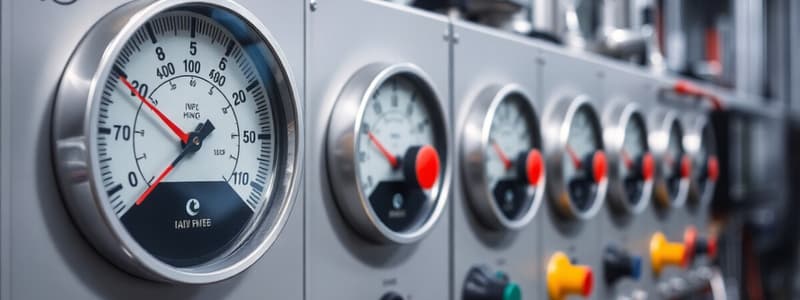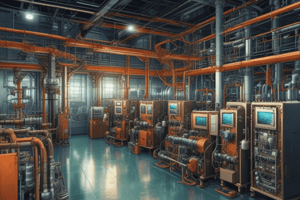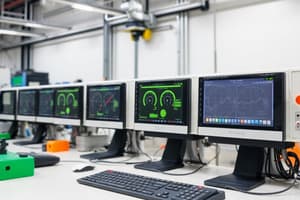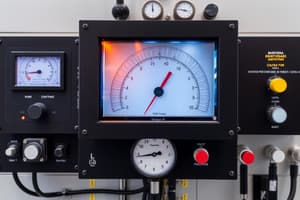Podcast
Questions and Answers
Which activity is NOT typically performed by instrumentation technicians?
Which activity is NOT typically performed by instrumentation technicians?
- Maintaining automation devices
- Calibrating automation devices
- Installing automation devices
- Designing new instruments (correct)
In industrial automation, what is the primary role of instrumentation?
In industrial automation, what is the primary role of instrumentation?
- Automating hazardous tasks exclusively
- Enhancing the aesthetic appeal of the factory
- Providing timely data for informed decision-making (correct)
- Reducing the number of employees required
What distinguishes control engineering from instrumentation engineering?
What distinguishes control engineering from instrumentation engineering?
- Control engineering emphasizes the measurement of process variables.
- Instrumentation engineering is about measurement, while control engineering uses data to automate processes. (correct)
- Control engineering focuses solely on device maintenance.
- Instrumentation engineering applies data within feedback systems.
Which purpose of instrumentation and control directly contributes to reduced environmental impact?
Which purpose of instrumentation and control directly contributes to reduced environmental impact?
In an instrumentation system, which element is responsible for initially sensing the process variable?
In an instrumentation system, which element is responsible for initially sensing the process variable?
What is the function of a signal processing element in an instrumentation system?
What is the function of a signal processing element in an instrumentation system?
How does automatic control differ from manual control?
How does automatic control differ from manual control?
In process control, what is the primary purpose of maintaining variables within acceptable limits?
In process control, what is the primary purpose of maintaining variables within acceptable limits?
Which of the following describes a system in the context of industrial settings?
Which of the following describes a system in the context of industrial settings?
In a closed control loop, what is the role of feedback?
In a closed control loop, what is the role of feedback?
What is the purpose of an instrument loop?
What is the purpose of an instrument loop?
In a process flow diagram (PFD), which detail is typically omitted?
In a process flow diagram (PFD), which detail is typically omitted?
In instrumentation diagrams, what do symbols primarily represent?
In instrumentation diagrams, what do symbols primarily represent?
Why is the 4 to 20 mA signal range widely used in industrial instrumentation?
Why is the 4 to 20 mA signal range widely used in industrial instrumentation?
What is the key difference between measurement and detection?
What is the key difference between measurement and detection?
When would a normally-closed switch complete a circuit?
When would a normally-closed switch complete a circuit?
In temperature measurement, what is absolute zero?
In temperature measurement, what is absolute zero?
Which statement accurately describes how bimetallic thermometers function?
Which statement accurately describes how bimetallic thermometers function?
In instrumentation and control systems, what is the typical function of a control valve?
In instrumentation and control systems, what is the typical function of a control valve?
What type of pressure measurement is relative to atmospheric pressure?
What type of pressure measurement is relative to atmospheric pressure?
Flashcards
Instrumentation
Instrumentation
Design, equipping, and/or use of measuring instruments to determine real-life conditions in a plant's process.
Industrial automation
Industrial automation
A critical aspect in various industries, such as automotive, manufacturing, aerospace, pharmaceuticals, and food and beverage.
Instrumentation and Control Engineering (ICE)
Instrumentation and Control Engineering (ICE)
Branch of engineering that studies measurement/control of process variables and the design/implementation of related systems.
Instrumentation Engineering
Instrumentation Engineering
Signup and view all the flashcards
Control Engineering
Control Engineering
Signup and view all the flashcards
Quality Control
Quality Control
Signup and view all the flashcards
Conservation of Energy and Raw Materials
Conservation of Energy and Raw Materials
Signup and view all the flashcards
Safety
Safety
Signup and view all the flashcards
Savings in Installation
Savings in Installation
Signup and view all the flashcards
Material Balance & Product Accounting
Material Balance & Product Accounting
Signup and view all the flashcards
Coordination of Process Variables
Coordination of Process Variables
Signup and view all the flashcards
Research & Development
Research & Development
Signup and view all the flashcards
Enterprise Management
Enterprise Management
Signup and view all the flashcards
Instruments
Instruments
Signup and view all the flashcards
Critical instrument
Critical instrument
Signup and view all the flashcards
Non-critical instrument
Non-critical instrument
Signup and view all the flashcards
Reference Only
Reference Only
Signup and view all the flashcards
Instrumentation systems
Instrumentation systems
Signup and view all the flashcards
Sensor
Sensor
Signup and view all the flashcards
Variable Conversion Elements
Variable Conversion Elements
Signup and view all the flashcards
Study Notes
- The text provides information on instrumentation and control engineering.
Instrumentation
- Instrumentation involves designing, equipping, and using measuring instruments to determine real-world conditions in a plant's processes for observation, measurement, and control.
- Instrumentation technicians install, maintain, and calibrate devices used in industrial automation.
- Accurate instrument measurements are important for safety, product quality, and profitability.
- Industries that rely on instrumentation are petrochemical, power, water treatment, pulp and paper, and mining/steel manufacturing.
- Job titles include instrument, I&E, I&C, electrical, and electronics technician.
Industrial Automation
- Enhances operational efficiency, product quality, and workplace safety.
- Automates hazardous tasks and provides timely data for decision-making to maintain operational standards.
- Enables performance analysis and optimization, reducing maintenance costs and downtime, driving advancements in productivity and operational excellence.
Instrumentation and Control Engineering (ICE)
- It measures and controls process variables.
- It designs and implements associated systems.
- Process variables include pressure, temperature, humidity, flow, pH, force, and speed.
- Combines instrumentation and control engineering branches.
Instrumentation Engineering
- Focuses on designing, developing, and maintaining instruments/devices that measure, monitor, and control physical and environmental variables like pressure, temperature, flow, and level.
- Integrates principles from electronics, control systems, and process engineering to ensure precise, reliable operation of industrial processes.
Control Engineering (Control Systems Engineering)
- It applies control theory to design systems with desired behaviors.
- Typically used in manufacturing facilities and process plants.
- It employs sensors to measure device output and provide feedback to the controller for correction purposes.
- Automatic control manages a device without human input, like cruise control.
- Control systems engineering activities are multidisciplinary and focus on control system implementation often derived from mathematical modeling.
- Instrumentation and control are key for gathering data and changing system parameters.
- They have a significant role in control loops.
Distinct Aspects
- Instrumentation engineering emphasizes measurement and monitoring process variables.
- Uses sensors and transducers to ensure accurate data collection.
- Control engineering applies data within feedback systems to regulate and automate processes.
- Ensures desired performance occurs without human intervention.
- Instrumentation focuses on gathering information.
- Control engineering uses this information to design dynamically responsive systems.
- Integration of the two optimizes and automates processes in industries.
- Ensures safety, efficiency, and precision in modern tech systems.
Purpose of Instrumentation and Control
- It maintains consistent product standards by monitoring/regulating process variables (temperature, pressure, flow).
- Minimizes variations in production for high-quality outputs that meet predefined specifications.
Conservation of Energy and Raw Materials
- Optimizes resource utilization to reduce energy consumption and minimize raw material waste.
- By implementing efficient monitoring and control systems, industries can achieve sustainable production, lower costs and lessen environmental impact.
Safety
- Protects workers, equipment and the environment through precise instrumentation and automated controls.
- Detects and prevents hazardous conditions.
- Ensures timely responses to potential risks and minimizes accidents, and ensure regulatory compliance.
Savings in Installation
- Designs and implements efficient instrumentation and control systems that simplify setup processes.
- Reduces installation time, and minimizes costs.
- Provides better performance with fewer components and less complexity through advanced technologies.
Material Balance & Product Accounting
- Accurately tracks materials entering and leaving a system.
- Allows industries to maintain balance, avoid losses, and account for resources.
- Enhances transparency and efficiency in process management.
Coordination of Process Variables
- Synchronizes multiple process variables such as temperature, pressure, and flow.
- Ensures smooth operations and reduces fluctuations.
- Improves the overall efficiency of industrial processes.
Research & Development
- Plays a vital role in R&D by providing precise measurements and controls for experiments and innovation.
- Researchers can simulate, test, and refine processes, advancing technology and industry practices.
Enterprise Management
- Integrates instrumentation and control systems into broader organizational strategies.
- Enables real-time monitoring, data analysis, and decision-making.
- Supports better resource allocation, process optimization, and overall business efficiency.
Instruments
- Instruments are devices used for direct or indirect measurement, monitoring, and/or control of a variable.
- Includes indicators, controllers, annunciators, switches, and pushbuttons.
- Instruments measure or manipulate physical variables such as flow, temperature, level, or pressure.
- They can be simple (valves) or complex (analyzers).
- Instruments often comprise control systems of varied processes.
Classification of Instruments
- Critical- Non-conformance could compromise product or process quality (ex: pressure gauge).
- Non-critical- Function is more operationally significant, but doesn't affect product/process quality (ex: temperature indicator).
- Reference only- Function is not critical to product quality or equipment operation (ex: wall-mounted room thermometer).
Instrumentation Systems
- Provides information about the physical value of some variable being measured.
- Variables are called process variables indicating a condition of process liquid/gas.
- Variables can change the manufacturing process.
- Consists of a single unit that gives an output signal or reading according to the magnitude of the unknown applied variable.
Elements of Instrumentation Systems
- Sensor- The first element in a measuring system, in contact with the process. Gives an output depending on the value of the variable.
- Variable conversion elements- Needed when the output variable of primary transducer is in inconvenient form where it has to be converted.
- Signal processing elements- Exists to improve the output quality of a measurement system.
- Signal Transmission- Transmits the signal to a remote point and displays/records the signal.
Types of Control
- Manual- Human operators directly monitor and adjust process parameters via instruments for desired conditions.
- Automatic- Automatic control uses instruments (PLCs or DCS) to monitor variables and make adjustments automatically.
Advantages
- Manual: Flexible and allows human judgment for unexpected situations.
- Automatic: Precise, consistent, and faster response to changes.
Disadvantages
- Manual: Prone to errors, slow response, less precise adjustments.
- Automatic: Higher initial cost, requires maintenance, depends on instrumentation.
Process
- A series of methods/steps to transform raw materials into a final product.
- Can involve physical, chemical, mechanical, or biological operations.
- Varies across industries (petroleum refining, pharmaceuticals, food/beverage)
- Each process is designed for a specific output, focusing on efficiency, quality, and cost-effectiveness.
Process Control
- Regulating/manipulating key variables in a process (temperature, pressure, flow rate, level, chemical composition).
- Ensures smooth, efficient operations that meet quality/quantity specifications.
- Maintains variables within acceptable limits to prevent equipment damage, ensure safety, and produce a consistent product.
System
- A collection/arrangement of physical components working together to achieve a specific function/purpose.
- Components are interconnected, and operate as a unified whole.
Control System
- System designed to regulate or direct behavior of another system/itself to achieve desired outcomes.
- Components measure, monitor, and adjust variables to optimize system performance.
Types of Control Loop
- Open- Actions are based on predetermined schedules/inputs without considering real-time conditions.
- Closed- Uses feedback to maintain the process variable at the desired setpoint.
Advantages
- Open: Simple, inexpensive, easy to implement.
- Closed: Accurate, self-correcting, responsive to changes.
Disadvantages
- Open: Prone to inefficiencies and errors if conditions vary significantly.
- Closed: Requires complex components, slower response.
Instrumentation & Control Loop (Instrument Loop)
- System that combines instruments/control functions to manage and regulate a process variable.
- Interconnected/allows signals to pass, enabling monitoring, measurement, and control.
- Ensures process operates efficiently, safely, and within parameters by maintaining control over key variables.
Elements of Instrument Loop
- Process- When raw materials are transformed by controlling certain variables.
- Measuring Element- Senses/measures a process variable (e.g. temperature, pressure), converting it into a signal.
- Receiving Element- Interprets signals (e.g. controller, indicator) and determines the necessary action.
- Final Control Element- Directly manipulates the process (valve or motor) based on signals from the receiving element.
Foundational Concepts
- Process Variable- Measured and controlled property of a process (temperature, pressure, flow, level).
- Set Point (SP)- Target value/desired level for the process variable (defined by the operator/system).
- Controller Output- Signal sent by the controller to the final control element.
- Manipulated Variable- Process variable adjusted by the controller to bring the measured variable closer to the set point.
Process Technology
- Includes techniques, tools, equipment, methods used to transform raw materials into finished goods or desired outputs.
- Encompasses design, development, and operation in industries like manufacturing, oil & gas, pharmaceuticals, and food.
Process Diagrams
- Back flow diagrams are a simplified representation of a process.
- Shows main process units/blocks, their interconnections (straight lines).
- Provides a basic overview without detailed equipment/process information.
Descriptions
- Simple flow sheet.
- Process engineer begins process design (block diagram) where only the feed and product streams are identified.
- Input-output diagrams: not very detailed, useful in early development stages.
Process Flow Diagram
- BFD processes are then broken down into functional elements like reaction/separation sections.
- Identifies recycle streams, additional unit operations (achieve desired operating conditions).
- Provides more detailed representation (process) versus a BFD.
- Includes more equipment, process flowlines, operating conditions, and key process parameters.
Process Description
- Does note include piping or minor instruments.
- Flow rate, composition, operating conditions (of each stream) are all important
- How much heat is involved, as well as what type of stream they are
Piping and Instrumentation Diagram
- Overall design document for a process plant
- Highly detailed schematic - shows piping, equipment, valves, instrumentation in the process.
- Includes tag numbers, process control loops, and interconnections.
- Serves as blueprint for construction, operation, maintenance.
- Includes all the symbols that depict mechanical equipment, piping equipment, and instruments.
Instrumentation Symbols
- Includes the circles, lines and letters that convey information about the process
- There may even be notations on what device is in the system and how they are connected.
General Instrument or Function Locations
- Discrete/Shared Control are types of instument locations
- Display/Computer Function can determine the location of computer
- It could be located on the central panel, behind the panel, in the field, or on the Local Control Panel
Compressors
- Some types of compressors are: reciprocrating compressor, compressor with silencerss, rotary compressors and centrifugal types
Types of Line Symbols
- Process Line Symbols are visual representations utilized in diagrams like P&IDs and PFDs to illustrate how process materials (such as liquids, gases, or solids) flow through the system and how instruments connect to the process.
- Thick Solid Lines: Indicates the main process.
- Thin Solid Lines: Shows the instrument connections.
Signal Line Symbols
- Signal Line Symbols represent signal types connecting instruments, controllers, final control elements.
- Includes: Mechanical, electrical, pneumatic, and digital communication.
Valve and Actuator Symbols
- Valves may also be drawn as a "bow tie", with other varying types of valves.
Instrumentation Tagging System
- Tag numbering and Loop Identification within the system are all part of the system
- This specifies the type and function within the instrument.
Examples Process Diagrams
- (A) Block Flow Diagram.
- Production of Ethane comes from Etahnol
- Process Flow Diagram
Module 3 Notes
- Measurements determine the quantity of a specific parameter by comparing it to a standard, rather then if a variable is present or absent.
- Instruments here are thermometers, rather then signal outputs
Analog Measuring Devices
- Diagram represents the function of a system that is continous by nature
Characteristics of a Measuring Element
- Accuracy in the reading
- Proportional relationship with input/output
- External influences must be considered
Methods of Measurement
- Direct method or Indirect (inferential) Method can be used for measurements
Types of Measurements
- Single Point vs Continous measurements
Switch
- A process switch can be normally on or off
Types of Switches
- Hand/Limit, Proximity/Pressure, level/temperature
According signals
- Recording in Analog, digital, or Bar Graph
According technology
- It can be Pneumatic, Electric, Electronic, Digital and Processor based
Temperature
- 3-15 psi range, and usually the mA for current
Module 6: Pressure Reading
- P= f/A, where p is pressure, f is the force, and a is the area
- Can be measure directly by: a probe, thermometer,
- There must also be considerations for Safety, cost savings, and inferences
- Guage- Measured relative to ambient pressure
- Differential- Measured when NOT at vacuum or atmosphere
- Absolute- Measured at VACUUM
Module 4: Instrumentation Ap
- Automation instruments are essential
- Safeguard instruments are designed to protect.
- Essential instruments measure and regulate key parameters
Studying That Suits You
Use AI to generate personalized quizzes and flashcards to suit your learning preferences.



